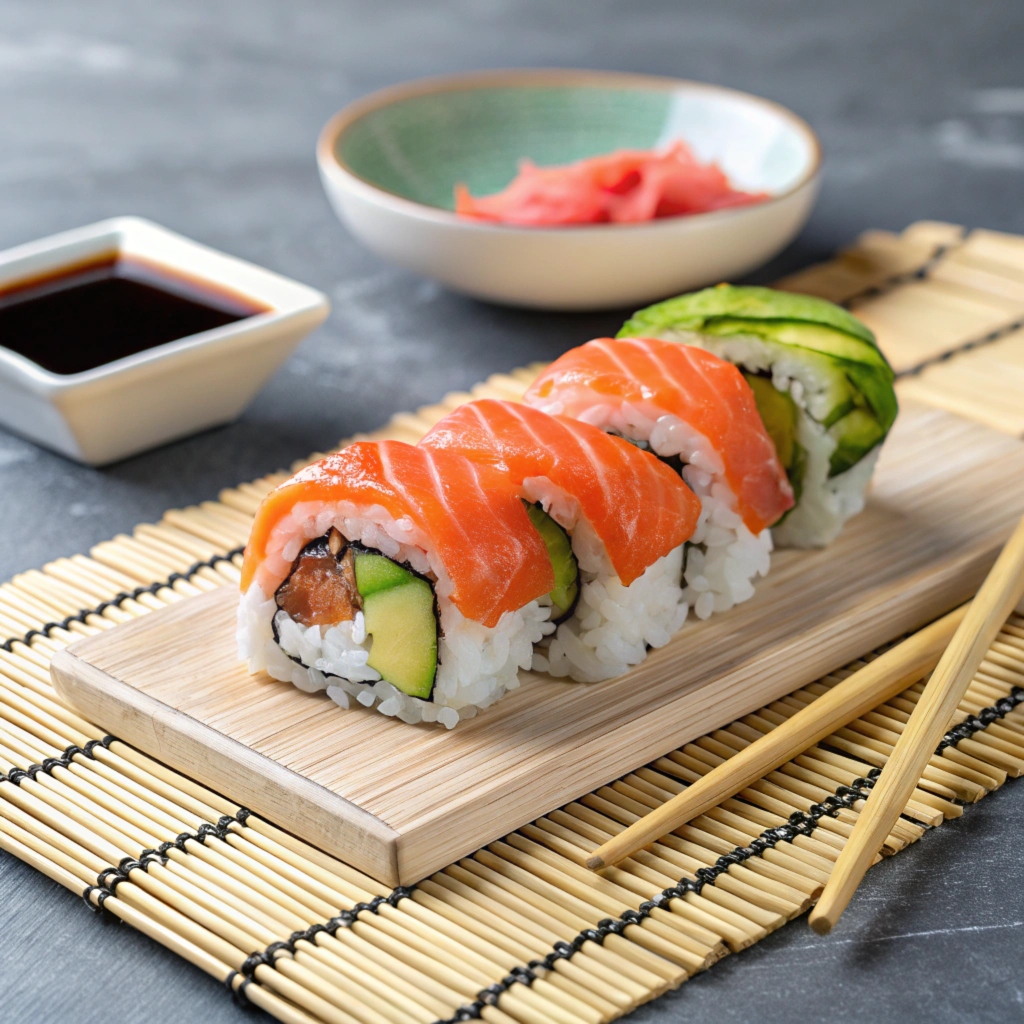Alaska Rolls
Are you a sushi lover? If yes, Alaska Rolls might just become your next favorite indulgence! These sushi rolls are the perfect blend of fresh ingredients, creamy textures, and a hint of umami flavor that makes sushi irresistible. Whether you’re an experienced sushi aficionado or just dipping your toes (or chopsticks) into the world of sushi, Alaska Rolls are a must-try. But what exactly are they, and why do people love them so much? Let’s dive into the delicious world of Alaska Rolls!
What Are Alaska Rolls?
Alaska Rolls are a popular type of sushi roll that combines fresh ingredients like salmon, avocado, and cucumber wrapped in a layer of perfectly cooked sushi rice and seaweed (nori). What sets them apart is their simplicity—each bite offers a burst of freshness and flavor without overpowering your palate. They’re not just a dish; they’re an experience.
Origins and Popularity
Why are they called “Alaska Rolls”? The name likely originates from the use of fresh salmon, reminiscent of Alaska’s famous fisheries. While their roots may not trace back to traditional Japanese sushi, Alaska Rolls have become a staple in modern sushi menus across the globe. From high-end sushi bars to cozy home kitchens, their popularity continues to grow, and for good reason—they’re versatile, delicious, and visually appealing.
Why Are They Called “Alaska Rolls”?
The inclusion of salmon—a fish often associated with the icy waters of Alaska—is the primary reason behind the name. While the roll itself doesn’t have direct ties to Alaska, the name captures the essence of fresh, cold-water ingredients. Think of it as a culinary tribute to the pristine waters and bountiful seafood of the region.
Key Ingredients in Alaska Rolls
To make the perfect Alaska Roll, it’s essential to understand its core ingredients. While the recipe allows for some flexibility, here’s what you’ll typically need:
The Signature Combination
- Sushi Rice: The foundation of any sushi roll, sushi rice is seasoned with rice vinegar, sugar, and salt to give it that characteristic tangy-sweet flavor.
- Nori (Seaweed): Thin sheets of roasted seaweed hold the roll together.
- Fresh Salmon: The star ingredient, salmon brings a rich, buttery flavor.
- Avocado: Creamy and smooth, avocado balances the richness of the salmon.
- Cucumber: Crisp and refreshing, cucumber adds a crunchy texture.
Variations in Ingredients
Alaska Rolls are highly versatile, making them perfect for customization. Here are some common variations:
- Spicy Alaska Rolls: Add spicy mayo or Sriracha for a fiery kick.
- Vegetarian Alaska Rolls: Substitute salmon with tofu or more veggies.
- Smoked Salmon Rolls: Use smoked salmon instead of fresh for a smoky flavor.
Sourcing Fresh Ingredients
When it comes to sushi, freshness is non-negotiable. Here’s how to ensure your ingredients are top-notch:
- Salmon: Choose sushi-grade salmon, which is safe to eat raw. Look for bright, firm, and translucent flesh.
- Avocado: Pick a ripe but firm avocado—press gently, and it should yield slightly.
- Rice: Use short-grain sushi rice for the perfect sticky texture.
Pro Tip: Always keep your ingredients chilled until you’re ready to assemble your rolls. Sushi is all about freshness, and warm ingredients can ruin the texture and flavor.
Common Ingredients Substitutes
- No sushi rice? Use quinoa for a healthier twist.
- Can’t find fresh salmon? Try canned or smoked salmon in a pinch.
- Want extra flavor? Add cream cheese or a drizzle of eel sauce!
How to Make Alaska Rolls at Home
Making Alaska Rolls at home is easier than you think! With the right tools, ingredients, and a bit of patience, you can create sushi that’s as good as—or even better than—what you’d find at a restaurant. Let’s break it down step by step.
Tools You’ll Need
Before we dive into the preparation, gather these essential tools:
- Bamboo Sushi Mat: For rolling your sushi like a pro.
- Plastic Wrap: Place this over the sushi mat to prevent sticking.
- Sharp Knife: A sharp, non-serrated knife ensures clean cuts.
- Rice Paddle: Helps spread the rice evenly.
- Cutting Board: To prepare your ingredients and roll.
Quick Tip: Wet your knife with water before cutting the rolls. It helps avoid sticking and gives you cleaner slices.
Step-by-Step Preparation Process
1. Cook the Sushi Rice
Start by cooking 1 cup of sushi rice (enough for 3-4 rolls). Rinse the rice thoroughly until the water runs clear, then cook it in a rice cooker or pot. Once done, mix it with rice vinegar (2 tbsp), sugar (1 tbsp), and salt (1 tsp). Let it cool to room temperature.
2. Prepare Your Ingredients
- Slice your salmon into thin, even strips.
- Cut the cucumber into matchstick-like pieces.
- Slice the avocado into thin, smooth strips.
3. Lay Out the Nori Sheet
Place a sheet of nori shiny side down on your bamboo mat. Make sure the longer side is closest to you.
4. Spread the Rice
Dip your hands in water to prevent sticking, then take a handful of rice and spread it evenly over the nori, leaving a 1-inch border at the top.
5. Add the Fillings
Layer the salmon, avocado, and cucumber horizontally across the center of the rice.
6. Roll It Up
Using your fingers, gently lift the edge of the bamboo mat closest to you. Begin rolling the sushi tightly while keeping the fillings in place. Roll until the nori edges seal together.
7. Slice the Rolls
Wet your knife, then cut the roll into 6-8 even pieces. Wipe the knife after each cut to keep slices neat.
Tips for Perfect Rolling Technique
- Keep It Tight: Apply gentle but firm pressure while rolling.
- Don’t Overfill: Less is more when it comes to sushi filling.
- Practice Makes Perfect: Your first roll might not look perfect, but it will taste amazing!
Common Mistakes and How to Avoid Them
Using the Wrong Rice
Sushi rice is short-grain and sticky, making it ideal for rolls. Don’t substitute with long-grain rice—it won’t hold together.
Overstuffing the Roll
While it’s tempting to load up on fillings, overstuffing makes it difficult to roll and causes the nori to tear.
Uneven Cuts
Use a sharp knife and wet it before each cut. A dull knife will crush the roll instead of slicing through cleanly.
Variations and Creative Twists
One of the best things about Alaska Rolls is their versatility. You can customize them to suit your taste or dietary preferences. Here are some fun variations to try:
Vegetarian Alaska Rolls
Swap out the salmon for marinated tofu, tempura sweet potato, or extra veggies. You’ll still get the creamy-crunchy texture combo.
Spicy Alaska Rolls
Add a kick by mixing spicy mayo or Sriracha into your fillings. You can also sprinkle chili flakes on top for extra heat.
Keto-Friendly Alaska Rolls
Skip the rice altogether and wrap your fillings in thinly sliced cucumber or nori sheets for a low-carb option.
“The secret to great sushi lies in the balance. Keep your ingredients fresh, your rice seasoned just right, and don’t be afraid to experiment!” – Sushi Chef Hiro Tanaka
Making Alaska Rolls for a Crowd
Hosting a sushi night? Prep your ingredients in advance to save time. Lay out an “assembly line” of rice, nori, and fillings so guests can roll their own Alaska Rolls. It’s a fun and interactive way to enjoy sushi together!
Quick Ingredient Checklist for Alaska Rolls
| Ingredient | Amount for 3 Rolls |
|---|---|
| Sushi Rice | 1 cup cooked |
| Nori Sheets | 3 sheets |
| Fresh Salmon | 100g (3.5 oz) |
| Avocado | 1/2 sliced |
| Cucumber | 1 small, julienned |
| Rice Vinegar | 2 tbsp |
| Sugar | 1 tbsp |
| Salt | 1 tsp |
Best Sauces to Pair with Alaska Rolls
A great sushi roll deserves an equally great sauce. While Alaska Rolls are delicious on their own, pairing them with the right sauce elevates the flavor to a whole new level. Here are some popular options:
Classic Soy Sauce
Soy sauce is the ultimate companion for sushi. Its salty, umami-rich flavor perfectly complements the freshness of Alaska Rolls. For an extra twist, add a touch of wasabi to your soy sauce for a spicy kick.
Creamy Wasabi Mayo
If you love creamy textures and bold flavors, wasabi mayo is your go-to sauce. It adds a smooth, tangy element that balances the richness of the salmon and avocado.
How to Make It:
Mix 2 tablespoons of mayonnaise with 1 teaspoon of wasabi paste. Adjust the amount of wasabi to your spice tolerance.
Unique Fusion Sauces
Looking to experiment? Try these creative sauces:
- Spicy Mango Sauce: Blend ripe mango with chili flakes and lime juice for a sweet-spicy pairing.
- Ginger-Soy Glaze: Combine soy sauce, grated ginger, and a bit of honey for a sticky, flavorful glaze.
Serving Suggestions and Presentation Tips
Presentation is half the experience when it comes to sushi. Here’s how to serve your Alaska Rolls in style:
Plating Alaska Rolls Like a Pro
Arrange your rolls on a clean, flat plate in a straight line or circular pattern. Garnish with:
- Thin slices of lemon for a pop of color.
- Pickled ginger and wasabi on the side.
- A sprinkle of sesame seeds or chopped scallions for added texture.
Pairing with Beverages
Sushi pairs well with a variety of drinks. For Alaska Rolls, consider:
- Green Tea: Its earthy flavor complements the freshness of the rolls.
- Sake: Opt for a light, dry sake to enhance the sushi’s flavors.
- White Wine: A crisp, dry wine like Sauvignon Blanc works wonderfully.
Hosting a Sushi Party
Hosting a sushi night? Set up a DIY sushi bar with prepped ingredients and sauces. Provide bamboo mats and encourage guests to roll their own creations—it’s a fun way to bring people together!
Where to Find the Best Alaska Rolls
If you’re not in the mood to make Alaska Rolls at home, don’t worry—you can find them in many restaurants around the world. Here’s where to start:
Top Restaurants Serving Alaska Rolls
- Nobu (Global Locations): Known for its high-end sushi, Nobu often includes Alaska Rolls on its menu with a creative twist.
- Sushi Den (Denver, USA): Famous for its fresh, authentic sushi rolls.
- Tsukiji Fish Market (Tokyo, Japan): For the freshest sushi experience.
Regional and Global Popularity
Alaska Rolls may have originated in the U.S., but their popularity spans the globe. You’ll find unique versions in places like:
- Los Angeles: Home to countless fusion sushi restaurants.
- Toronto: A hub for creative sushi rolls inspired by diverse cuisines.
- Sydney: Where seafood meets innovation in sushi-making.
Frequently Asked Questions
Still curious about Alaska Rolls? Here are answers to some common questions:
Are Alaska Rolls Gluten-Free?
Yes, but only if you use gluten-free soy sauce and check that your nori and other ingredients don’t contain hidden gluten.
Can I Freeze Alaska Rolls?
While it’s possible, it’s not recommended. Freezing changes the texture of the rice and fish, diminishing the roll’s quality. Always enjoy sushi fresh!
What’s the Best Way to Reheat?
Sushi is best served cold or at room temperature. However, if you’ve stored in the fridge, let them sit out for 15-20 minutes before eating.
“Sushi isn’t just food; it’s an art form. Take your time to enjoy every bite, and don’t be afraid to experiment with flavors and presentations.” – Chef Yuki Nakamura
Conclusion
Whether you’re making Alaska Rolls at home, enjoying them at a sushi bar, or experimenting with creative variations, one thing is certain—they’re a treat for the senses. With their perfect balance of flavors, textures, and simplicity, Alaska Rolls are more than just a sushi roll; they’re a celebration of fresh, delicious ingredients. So, grab your sushi mat or your favorite chopsticks and dive into the world of Alaska Rolls today!

